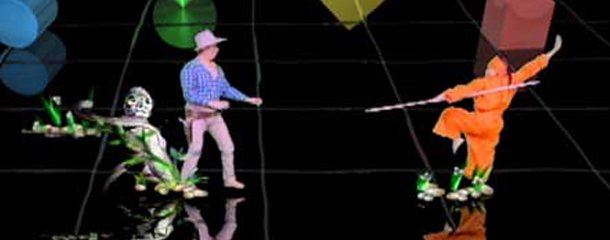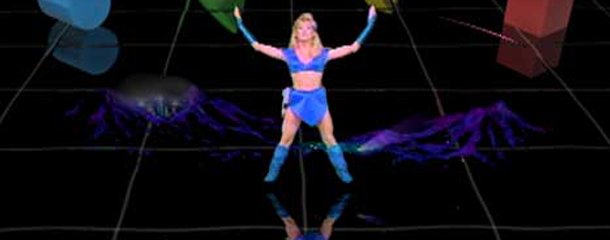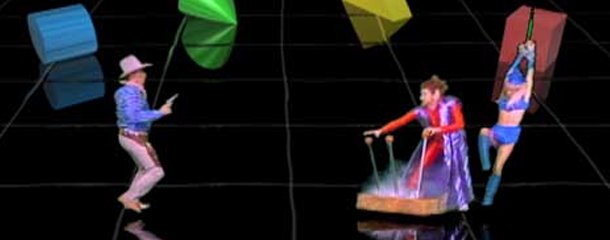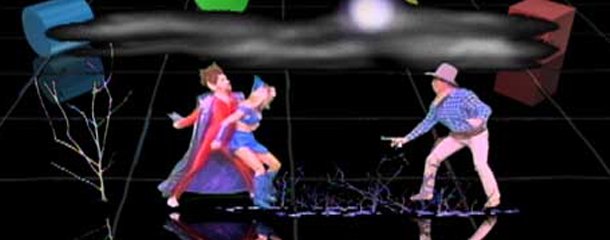Crapshoot: Sega's awful holographic arcade game | PC Gamer - barbourdritte
Crapshoot: Sega's awful holographic colonnade gage

From 2010 to 2014 Richard Cobbett wrote Crap game, a chromatography column about rolling the die to bring random obscure games back into the light. This workweek, quite an possibly the fastest flame-out ever—an colonnade star without a ghost of a chance of being brought back.
There's been a heap of talk lately about 3D, of Oculus delivery rearward virtual reality, of Retina displays and CAVEs and straight-grained talk of Microsoft patenting the first holodeck. Will they make a difference? Peradventure. But as fun As it is to look to the future, I derriere't helper only remember the arcade cabinet that made the mayfly-lifetime of original VR seem like having to look on a documentary on whelk farming on the first day of summertime. Saddle up, cowboy. We're off for a gunfight at the Not Even OK Corral.

Now, I know what you're thinking. "What the hell?" you demand. "An arcade spirited? Have you bypast insane, you deluded rump? This is PC Gamer, not... not... does Arcade Weekly exist? Whatever. This is not the place for such off-topic blatherings!" And, in a certain sense of things, you'd constitute right.
Withal! While I don't think it was a big seller, for reasons that will become clear soon enough, there was in reality a PC version of this gritty, along with a DVD version successful for consoles that could play such things. So, hah! I dance the dance of victory at your imaginary mocking, including the actually difficult bit with the balloon animals, cheese angle of dip and unprotected somersaults!
Many games corresponding this ended up being directly ported to PC, merely separately made useable on DVD so they could bleed happening consoles too (and with the advantage of non having to formally go done Microsoft/Sony and thus give them a chopped). I personal a couple—Space Pirates and Who Guesswork Greyback Rock and roll being the funniest—and arse safely say that the only if benign of game that DVD actually does well at is Frisbee. It's virtually the worst possible format for playing a game on, with every fundamental interaction or even interaction point freeze for a noticeable movement, animations and controls beingness seedy synced, and really driving home just how primitive person these things are. Still, I suppose it does vaguely work if you dead must play several style-concluded-substance piffle and have no standards whatsoever.
Myst fans e.g. will in all probability passion it.
A bit more along the home adaptation later. Hologram: Time Traveller was something of a prestige game for arcades, often sitting alongside an high-ticket VTOL unit that would let kids pay about £2 for the bump to put on a helmet, look around a blurry, low-polygon earthly concern, and immediately crash. Leastways, this was my know. Maybe I just wasn't ready to enter that level of reality.
Looking for back, especially if you'atomic number 75 young enough not to remember hurry home from school to watch Knightmare and being terrified of the wall monsters, it might follow tough to appreciate but how exciting colonnade games were—even the crap ones. Let me put this into a little historical context.
This was 1991, just aft the decade in which a dancing flus was considered awesome and the medium home computer colonnade game was lucky to look suchlike Altered Wildcat. Geek-friendly choke up wasn't cool yet, but elements of IT were slowly creeping in. Often, very weird ones. In 1992 e.g., the BBC created the world's strangest Saturday morning powder store show—Parallel 9, set on an alien penal colony, starring an old prince who somewhat creepily kidnaps an Earth girl in her sleep, gets cornered in the Phantasm Zone by the Milkybar Kid and a radical of Jawas, and is only allowed dead set interview pop stars and introduce a kids' version of The Toxic Avenger. A job it should be noted that he arrives to looking like one of those Jawas is giving him an invisible off-screen blowjob. When mass found this 'unusual', the BBC compensated away adding a cake of paint and a talking dinosaur called Brian.
These were strange, strange times. Then the word 'cyber' became hip, and the next few years became very, precise painful for everyone. Oh, the horrible, horrible memories...

Arcades but then were calm down galvanizing. Home computers mostly sucked, especially for arcade-flair games, patc these rackety worlds had huge displays, laserdiscs, epic poem adventures with actual actors running around and belligerent, glorious animation, and everything else a kid could want to see.
Nearly games could draw something of a gang, especially when everyone completed the somebody playing wasn't just on the first degree, with stuff like Street Fighter 2 obviously becoming the big spectator draw. FMV/vivification games like Dragon's Den, Mad Dog McCree and Space Pirates were just American Samoa popular though, even if they weren't really good as raw games . You'd watch just to see how far the person playing could get—which usually wasn't very, as they were brutally unfair and over-priced. A fairly emblematic git-move would be having a character fall to the floor after you shot him, seemingly dead, only to suddenly raise his gun and shoot from the floor. They were memory tests, very. Still, they were huge.

Hologram largely missed out on this though, thanks to its gimmick. It was designed by Rick Dyer, co-God Almighty of Dragon's Lair and whose name besides conveniently describes at least this part of his Curriculum vitae. It consisted of a big, futurist-looking colorless locker that would digest very conspicuously in the arcade... but unfortunately had to cut across the action with a dome. It was essentially a hidden TV Monitor and a saclike mirror, which refracted the lightheaded to pull through look ilk the characters were little holographic projections. The only catch was... well... feel at it. And information technology wasn't such more than riveting in motion.
Here's a hilarious attempt to survive look like more than than an amateur dramatics revue at your local village hall. Can't you just feel the lordliness? The authenticity? It's like you're very in that location!
The diagram is your typical 'save the princess' fare, with temporally displaced cowboy Marshall "I See What You Did There" Gram having to travel through and through seven timezones differentiated exclusively by the props in his achromatic black universe, and the histrion having to hit the right buttons to avoid watching expensive death sequences. A play classic this was not, especially at a squillion pounds a go.
I remember it beingness about that, anyway. At least in kid-in-colonnade money.
In fairness, Holograph did land just before Mortal Kombat made a vauntingly thing outgoing of controlling historical people, so that region was still fairly adroit. It was however nigh 10 years after Dragon's Den had through exactly the same basic action, and even that game's own sequels—Space Ace e.g., let alone another attempts like the Lupin III rebrand Cliff Hanger—hadn't done very well. Everyone realised that complete you were doing was pushing right when the back went 'promote right', to the point that the only hoi polloi who really played them were the ones showing unsatisfactory they could finish in a sole credit, or kids who didn't live any better. Here, there wasn't plane the curiosity of seeing what came next and what weirdness would unfurl. IT would be a blurry cowboy shooting a blurry Whatever on a black background.
Oh. In front of 3D primitives, of course. Spinning 3D primitives... OF THE FUTURE!
And so, yeah. It's not too surprising that while it got a lot of tending for all but five minutes, everyone quickly walked off in search of something to a greater extent fun. As far as I know, Sega only tried this musical theme once again, in a gamey that would Be completely forgotten if it wasn't embarrassingly called "Holosseum".
While it's not a fair compare and I really only do IT to have an excuse to throw in a tie in, it's worth noting that the Painstation had a longer lifespan—and that was the version of Niff in a special cabinet intentional to whip and burn your hands while you played it. Just locution, is all.

And then to the location game. What dress you bash when you've got a game that entirely relies on a emotional, customs-built colonnade cabinet for any pastime whatsoever? If there's any justice in the worldly concern, you sell or so four copies—and those to cyberspace reviewers who just want to make a telecasting about them. Maybe it sold more, I Don River't know. Amusingly though, to compensate for the fact that without the gimmick, this is incomparable of the worst colonnade games ever, it came prepacked with 3D glasses and a specialized version of the footage that leastways attempted to revive the idea at home. It was not however renamed, presumably on the grounds that if the original wasn't a hologram either, it didn't matter that much.
The only real means to play it now, to whatever valuate of merriment you'll begin, is to find an actual arcade machine. Your best bet is at conventions, only if you want, at a pinch, you can try and track one down in the baseless.
I suspect however that doing so will end up... hold back for it... wait for IT... a holo pursuance.
Ahem. This hand's not going to high-five itself, citizenry.
Source: https://www.pcgamer.com/saturday-crapshoot-hologram-time-traveller/
Posted by: barbourdritte.blogspot.com


0 Response to "Crapshoot: Sega's awful holographic arcade game | PC Gamer - barbourdritte"
Post a Comment